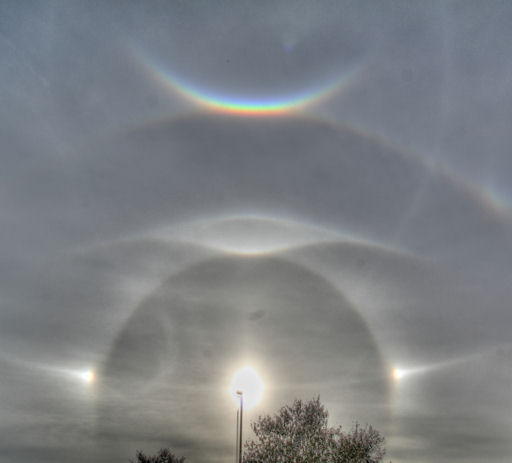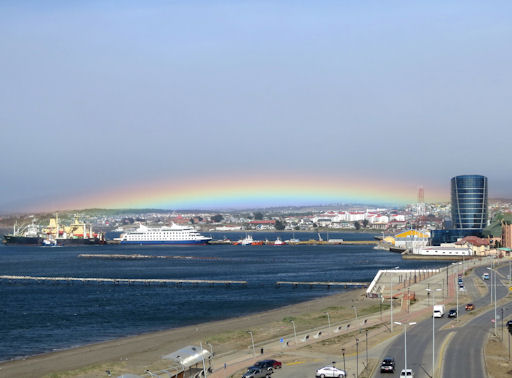Listen to radar echoes from satellites and meteors, live on listener-supported Space Weather Radio. | | |
MINOR CME IMPACT: A minor CME hit Earth's magnetic field on Oct. 31st around 1500 UT. Polar geomagnetic storms are possible in the hours ahead. Aurora alerts: text, voice.
HALLOWEEN MOON AND JUPITER: Trick or Treaters, look for the nearly full Moon tonight rising in the east. The bright "star" not far below the ghostly-pale lunar disk is Jupiter.Tomorrow night, the Moon and Jupiter will be even closer together. Sky maps: Oct. 31, Nov. 1.
AMAZING ICE HALO DISPLAY: Yesterday, sky watchers around the Marshall Space Flight Center in Huntsville, Alabama, witnessed something amazing: A complex network of luminous arcs and rings surrounded the afternoon sun. "I've never seen anything quite like it," says eyewitness Bill Cooke, head of NASA's Meteoroid Environment Office. Solar physicist David Hathaway snapped this picture of the display:

Image credit and copyright: David Hathaway/NASA/MSFC
The apparition is almost certainly connected to hurricane Sandy. The core of the storm swept well north of Alabama, but Sandy's outer bands did pass over the area, leaving behind a thin haze of ice crystals in cirrus clouds. Sunlight shining through the crystals produced an unusually rich variety of ice halos.
"By my count, there are two sun dogs, a 22o halo, a parahelic circle, an upper tangent arc, and a parry arc," says Chris Brightwell, who also photographed the display. "It was amazing."
"Very impressive," agreed onlooker Kyle Winkleman. "This was a once-in-a-decade event for our area."
If the display really was a result of Sandy, sky watchers might not have to wait a decade for the next show. Some researchers believe that superstorms will become more common in the years ahead as a result of climate change, creating new things both terrible and beautiful to see overhead. Sky watchers in the storm zone should remain alert for the unusual.
Realtime Space Weather Photo Gallery
GROUND-HUGGING RAINBOW: Most rainbows arch up into the sky, but on Oct. 27th, Stefan Elieff of Punta Arenas, Chile, photographed one that seemed to hug the ground:

"Scattered rain clouds were rolling in low over the hills behind the city when this unusually low rainbow appeared," says Elieff.
Although low rainbows are seldom seen, they are actually quite common. They appear whenever raindrops are illuminated by a high-hanging sun. "A rainbow's center and the sun are always on opposite sides of the sky," explains atmospheric optics expert Les Cowley. "So when the sun is high, the rainbow is low. Indeed, as the sun climbs, the rainbow sinks--sometimes right into the sea."
Look for more atmospheric optics phenomena, rare and otherwise, in the realtime photo gallery:
Realtime Space Weather Photo Gallery
Realtime Comet Photo Gallery
Realtime Aurora Photo Gallery
Realtime Noctilucent Cloud Photo Gallery
[previous years: 2003, 2004, 2005, 2006, 2007, 2008, 2009, 2011]

